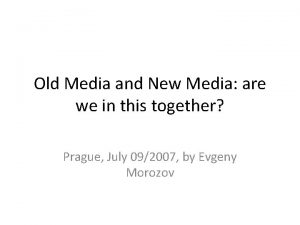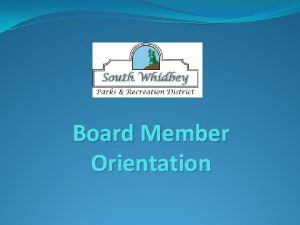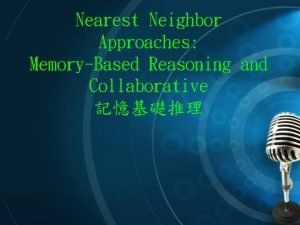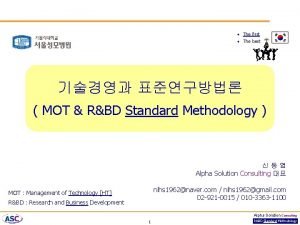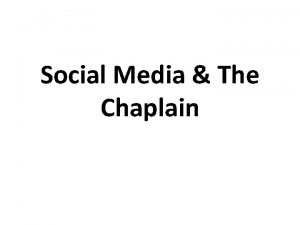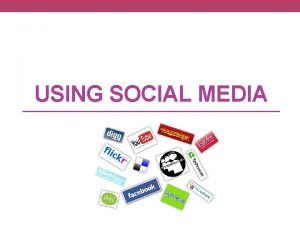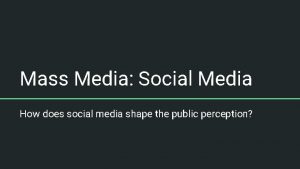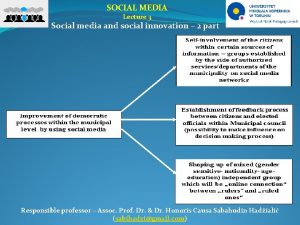Introduction to New Media Social Media and Social





























- Slides: 29

Introduction to New Media Social Media and Social networking Types / Honeycomb Framework

Social Media

“Websites and applications that enable users to create and share content or to participate in social networking. ”

Social Networking and Types

“Services that allow you to connect with other people of similar interests and background. Usually they consist of a profile, various ways to interact with other users, ability to setup groups, etc. ”

Types: ØSocial News Ø Media Sharing Ø Micro blogging Ø Blog comments Ø Bookmarking sites Ø Blog forums

Bookmarking Sites Services that allow you to save, organize and manage links to various websites and resources around the internet. Most allow you to “tag” your links to make them easy to search and share. The most popular are Delicious and Stumble Upon.

Social News Services that allow people to post various news items or links to outside articles and then allows its users to vote on the items. The voting is the core social aspect as the items that get the most votes are displayed the most prominently. The community decides which news items get seen by more people. The most popular are Digg and Reddit.

Media Sharing Services that allow you to upload and share various media such as pictures and video. Most services have additional social features such as profiles, commenting, etc. The most popular are You. Tube and Flickr.

Blog comments and forums Online forums allow members to hold conversations by posting messages. Blog comments are similar except they are attached to blogs and usually the discussion centers around the topic of the blog post. There are MANY popular blogs and forums.

Micro Blogging Services that focus on short updates that are pushed out to anyone subscribed to receive the updates

Honeycomb Framework

To help make sense of the complexity of Social Media, honeycomb framework of seven social media building blocks is presented: identity, conversations, sharing, presence, relationships, reputation, and groups.

Identity building block

Content that focuses on personal information and stories often relate to users at the identity level. Common CTAs that encourage users to “share their story” are often working on this functional block.

Conversation Building Block

Arguably, this is the most basic CTA of all social media: “Comment”, “Tweet”, “Email”, etc. Since social media is all about communication, most CTAs encourage conversation in one form or another.

Relationship Building Block

Encouraging users to form bonds with each other at the individual level has been a corner stone of several virtual communities. In the beginning at least, this was the very idea of Facebook's purpose. “Invite a friend” CTAs are very typical for this functional block.

Group Building Block

The difference between this functional block and the relationship block is the scale of the user connecting with other users. CTAs that invite users to join a larger community (i. e. a Facebook page) take the relationship building to a whole different level.

Sharing Building Block

Much like the conversations block, this functional block is also primary function of social media. Most CTAs in this block will even use the word “share” to promote the exchange and flow of digital content.

Presence Building Block

The typical call for a status update isn’t as common as other forms of CTAs, but can be highly effective for physical locations and virtual communities. This functional block is often enhanced with “check in” types of CTAs.

Reputation Building Block

Have you ever wondered why so many Facebook games have you share your score with your friends? It’s because sharing results, scores, or level accomplishments is a great CTA for enhancing the reputation building aspect of social media.

Conclusion By analyzing the Social Media Honeycomb’s seven building blocks firms can monitor and understand how social media activities vary in terms of their function and impact, so as to develop a congruent social media strategy based on the appropriate balance of building blocks for their community

Thank you
 New media vs old media
New media vs old media What is social media easy definition
What is social media easy definition Smanda mediadidik
Smanda mediadidik Introduction to social media
Introduction to social media New york, new jersey, pennsylvania, and delaware
New york, new jersey, pennsylvania, and delaware Fresh oil new wine
Fresh oil new wine Characteristics of the articles of confederation
Characteristics of the articles of confederation Marketing management kotler and keller
Marketing management kotler and keller New classical and new keynesian macroeconomics
New classical and new keynesian macroeconomics Chapter 16 toward a new heaven and a new earth
Chapter 16 toward a new heaven and a new earth Leanne keene french ambassador arrives from paris
Leanne keene french ambassador arrives from paris New classical and new keynesian macroeconomics
New classical and new keynesian macroeconomics What are the advantages and limitation of people as media
What are the advantages and limitation of people as media Social thinking adalah
Social thinking adalah Social thinking social influence social relations
Social thinking social influence social relations Split direct speech worksheet
Split direct speech worksheet Orchard 14
Orchard 14 New-old approach to creating new ventures
New-old approach to creating new ventures Njbta
Njbta Comparing progressive presidents roosevelt taft and wilson
Comparing progressive presidents roosevelt taft and wilson Subject mil
Subject mil Cartoon analysis about media and information literacy
Cartoon analysis about media and information literacy Introduction to the new mainframe: z/os basics
Introduction to the new mainframe: z/os basics New board member introduction speech
New board member introduction speech New neighbor introduction
New neighbor introduction Nti new technology introduction
Nti new technology introduction New product introduction process
New product introduction process Social darwinism vs social gospel
Social darwinism vs social gospel Hot media and cold media
Hot media and cold media Hot media and cold media
Hot media and cold media
